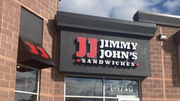News
Fatburger turns itself inside out in quest for healthier option
Fatburger's new protein burger -- an inside-out version of the better burger chain's typical offering – shaves off calories and carbs by nixing the bun and putting beef patties in its place.

August 19, 2014
In its quest to create a healthier burger option that remained true to the company's brand, Fatburger turned things inside out to find the solution.
Literally.
Fatburger's new "Skinnyburger" protein burger can be described as an inside-out version of the better burger chain's typical offering. The burger features one of Fatburger's standard patties sliced in half, then stuffed with typical toppings like lettuce, cheese, onions, pickles and tomatoes.
The Skinnyburger's appearance has earned it comparisons to the Double Down, KFC's sandwich offering that replaces the traditional bun with two fried chicken breasts.
Fatburger CEO Andy Weiderhorn isn't troubled by the comparison.
"We're thrilled that KFC is promoting it for us," said Weiderhorn in an interview.
But the similarities between KFC's Double Down and the Skinnyburger fade quickly once you look past the idea of using protein to hold a sandwich together.
While nutrition information for the Double Down is not currently listed on the KFC website, several other online sources (http://www.nutrition-charts.com/kfc-nutrition/, http://www.npr.org/blogs/health/2010/04/shots_v_the_double_down.html) peg the calorie count at around 540.
The Skinnyburger weighs in at just around 320, depending on how it is dressed.
That's a calorie savings of around 270 from the standard Fatburger, plus it's gluten free, said Weiderhorn.
"You can check so many boxes here – lower calories, gluten-free – and your flavor profile is unchanged," said Weiderhorn.
The Skinnyburger is the brainchild of Weiderhorn's son Thayer, who also serves as Fatburger's VP of Marketing.
Many better burger brands use a lettuce wrap for their low-carb protein burger option, explained Weiderhorn. Fatburger uses shredded lettuce – not whole leaves – to dress their traditional burgers. Adding a different type of lettuce would have probed problematic, and could have potentially caused supply issues. Thayer Weiderhorn's solution of ditching the bun, slicing the patty in half and stuffing toppings on the inside using existing menu items removed the complexity.
"Sometimes your best ideas are your simplest ideas," said Weiderhorn.
The absence of bread places the focus on the beef, too, according to Weiderhorn. Fatburger sources grain and corn-fed beef from steer of a particular age. Only certain cuts are used, and Fatburger uses a proprietary grind.
"It's a novelty in the sense of how it looks and people are amazed at how it holds together and how you can eat it," said Weiderhorn.
Re-engineering the existing burger into a lower calorie option that doesn't require additional beef is a bonus, too.
Beef prices are at an all-time high, according to Weiderhorn, with hamburger going for as much as $3 per pound and more.
Fatburger's franchise partners have had to push that cost on to the consumer at a price of around 25 to 35 cents per burger.
Still, customers "seem resilient," said Weiderhorn.
"We're seeing domestic same store sales increase north of 5 percent," said Weiderhorn. "They know what they want; they want the quality and the value and they are willing to splurge for it."
Fatburger's Skinnyburger is set to roll out nationwide this week.












